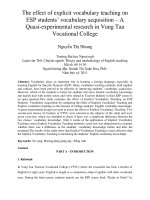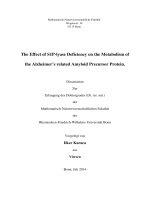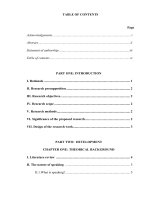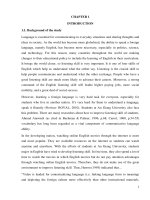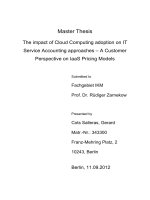The effect of explicit vocabulary teaching on ESP students’ vocabulary acquisition – A Quasi-experimental research in Vung Tau Vocational College
Bạn đang xem bản rút gọn của tài liệu. Xem và tải ngay bản đầy đủ của tài liệu tại đây (205.46 KB, 8 trang )
The effect of explicit vocabulary teaching on
ESP students’ vocabulary acquisition – A
Quasi-experimental research in Vung Tau
Vocational College
Nguyễn Thị Nhung
Trường Đại học Ngoại ngữ
Luận văn ThS. Chuyên ngành: Theory and methodology of English teaching
Mã số: 60 14 10
Người hướng dẫn: Hoành Thị Xuân Hoa, PhD.
Năm bảo vệ: 2011
Abstract: Vocabulary plays an important role in learning a foreign language, especially in
learning English for Specific Purposes (ESP). Many vocabulary teaching methods, both implicit
and explicit, have been proved to be effective in improving students’ vocabulary acquisition.
However, which of the methods is better for students who have limited vocabulary knowledge
and mainly deal with mostly nouns and verbs related to Tourism Industry in their ESP course is
an open question.This study examines the effect of Explicit Vocabulary Teaching on ESP
Students’ Vocabulary Acquisition by comparing the effect of Implicit Vocabulary Teaching and
Explicit vocabulary teaching on the increase of college students’ English vocabulary knowledge.
A quasi-experimental design was used to assess the effect of Explicit Vocabulary Teaching. Two
second-year classes of Cookery at VTVC were selected as the subjects of the study and were
given a pre-test, which was intended to check if there was a significant difference between the
two classes’ vocabulary knowledge. After 6 weeks of the application of Implicit Vocabulary
Teaching versus Explicit Vocabulary Teaching methods, a post-test was administered to examine
whether there was a difference in the students’ vocabulary knowledge before and after the
treatment.The results of the study show that Explicit Vocabulary Teaching is more effective than
the Implicit Vocabulary Teaching in increasing the students’ English vocabulary knowledge.
Keywords: Từ vựng; Phương pháp giảng dạy; Tiếng Anh
Content
PART A – INTRODUCTION
1. Rationale
In Vung Tau Tourism Vocational College (VTVC) where the researcher has been a teacher of
English for eight years, English is taught as a compulsory subject together with other vocational
ones. During the final course, students mainly use the ESP course book “Ready to Order” by
Baude, A. Iglesias, M and Inesta, A (2004) to learn integrated English language skills: Listening,
Speaking, Reading, and Writing. However, Listening and Speaking are the primary skills which
are designed on a large number of vocabulary for specific purposes (Food & Beverage). Most of
vocabulary in this material are unfamiliar to the students. During eight years of teaching, the
researcher has observed the fact that many students cannot remember and retain ESP words
though they try a lot in learning them. The level of students at VTVC is quite low so it is difficult
for them to get the word meanings in context with their limited vocabulary knowledge. That
students cannot understand, retain and use necessary ESP words causes frustration and results in
their negative attitude towards the ESP course. This situation makes the researcher as well as her
colleagues reconsider their method of teaching vocabulary. For this reason the research was
carried out with the aim to find a solution for the problem. A Quasi-Experimental Research was
conducted on ESP vocabulary teaching in which the Explicit and Implicit Vocabulary Teaching
Approaches were implemented.
Vocabulary is very important in language learning, as McCarthy states that “the biggest
component of any language course is vocabulary” (1990, p.viii). The status of vocabulary in
language learning and teaching has changed dramatically in the last two decades. “Since the mid-
1980s there has been renewed interest in the role of vocabulary in second language learning”
(Coady and Huckin, 1997, p.ix). Being aware of the important role of vocabulary, teachers have
been seeking for effective vocabulary teaching approaches for their own contexts. The main
problem that a classroom teacher is faced with in teaching vocabulary is how best to help
students understand, retain and use words in the target language. So far, there have been many
different approaches to vocabulary teaching and learning. Chacón-Beltrán reveals that “A great
deal of recent research into second language vocabulary teaching and learning has been devoted
to the comparison of explicit and implicit approaches” (2010, p.4).
Explicit vocabulary teaching is particularly useful for students who access ESP for the first time,
they are seen as beginning students who have a limited reading vocabulary and little exposure to
incidental vocabulary learning outside of school. Current research would suggest that it is
worthwhile to add explicit vocabulary to the usual inferring activities in the second language
classroom where the weak students are asked to deal with new words in reading passages.
Explicit method seems better for students who cannot find the clues to determine the meanings
of words in a strange context, as Beck, McKeown, & Kucan (2002) cited in Archer, A.L,
Hughes, C.A (2011, p.54) : “Explicit vocabulary instruction is particularly critical for struggling
readers, who do not read extensively and have more difficulty using contextual cues to determine
word meaning”
2. Aim of the study
The research was intended to find out the effect of Explicit Vocabulary Teaching on ESP
students’ vocabulary acquisition.
3. Research questions
In order to achieve the above aim, the research was carried out to find the answer to the
following research question:
To what extent does the Explicit Vocabulary Teaching help to improve ESP
students’ vocabulary acquisition?
The answer for the main research question was identified by answering two sub-research
questions:
1. Will there be any significant difference in the vocabulary knowledge between the
students who are taught vocabulary explicitly and those taught vocabulary implicitly?
2. Will there be any significant difference in the vocabulary knowledge before and
after the treatment between the Explicit Vocabulary Teaching and Implicit
Vocabulary Teaching?
4. Scope of the study
The study was carried out to aim at finding the effect of Explicit Vocabulary Teaching on ESP
Students’ Vocabulary Acquisition at VTVC. It was conducted on 42 students at two Cookery
Classes at Restaurant Management Department. A quasi-experimental design was implemented
so the sample was not randomized. All the subjects of the study were from two intact groups.
The research was carried out in one month and a half.
5. Method of the study
A Quasi-Experimental Research design was conducted to gain the research’s aim. Data were
collected from a pre-test and a post-test. Two intact classes were assigned as the control group
and the experimental group. The control group learned ESP vocabulary in the reading
comprehension texts through the implicit vocabulary teaching as the requirements in the course
book. The experimental group also received the same amount of ESP vocabulary but through the
explicit vocabulary teaching in which exercises and activities are used to focus students’
attention on vocabulary. The two groups were taught English in two different classes, so the
experimental group did not know they were receiving a special treatment.
To provide students sufficient time to attain vocabulary progress, the research was conducted in
one month and half which was also the allotted time the participants had for half of their ESP
course at VTVC. Students’ vocabulary knowledge in both experimental and control groups was
tested before the treatment and immediately after the treatment.
6. Organisation of the thesis
The thesis consists of three parts.
PART A – INTRODUCTION
This part provides the rationale, aim, scope, and method of the study.
PART B – DEVELOPMENT
This is the main part of the study which is comprised of 3 chapters.
CHAPTER 1: LITERATURE REVIEW
In this chapter, the theoretical background of the study is provided. It focuses on the second
language vocabulary teaching of English for General Purposes (EGP) and English for Special
Purposes (ESP).
CHAPTER 2: THE STUDY
This part reports the collection and analysis of the data and findings of the study.
CHAPTER 3: RESULTS AND DATA ANALYSIS
This part presents the results of the study and analysis of the collected data from the tests.
PART C – CONCLUSION
This part summarises the findings, states the limitation of the research, draws pedagogical
implications and offers suggestions for further research.
REFERENCES
* In English
Archer, A.L , Hughes, C.A (2011). Explicit Instruction: Effective and Efficient
Teaching. The Guilford Press
Baude, A. Iglesias, M and Inesta, A (2004). Ready to Order Student’s book. London: Longman
Baude, A. Iglesias, M and Inesta, A (2004). Ready to Order Teacher’s book. London: Longman
Beck, I. L., McKeown, M. G., & Kucan, L. (2002). Bringing words to life: Robust
vocabulary instruction. New York: Guilford.
Carter, R. & McCarthy, M. (1988). Vocabulary and language teaching. London: Longman.
Carter, R. & Nunan, D. (2001). Vocabulary. In The Cambridge Guide to Teaching English to
Speakers of Other Languages. Cambridge University Press, pp.42-47
McCarthy, M. (1990). Vocabulary. Oxford University Press
Coady, J. & Huckin, T. (1997). Second language vocabulary acquisition: a rationale for
pedagogy (pp. 273-288). Cambridge: Cambridge University Press.
Chacón-Beltrán, R (2010). Insights Into Non-native Vocabulary Teaching and Learning
Craik, F.I.M. & Tulving, E. (1975). “Depth of processing and the retention of words in episodic
memory” Journal of Experimental Psychology.
Cunningham,S, and Moor, P. (2005). New Cutting Edge – Elementary Student’s book.
London:Longman
Diamond, L. & Gutlohn, L. (2006). Vocabulary Handbook. Consortium on Reading Excellence,
Inc.
[online] Available from:
/>ts.org/article/9943/+explicit+teaching+vocabulary&cd=3&hl=vi&ct=clnk&gl=vn&sou
rce=www.google.com.vn [Accessed 4 June 2011]
Singleton, D.M. (1999). Exploring the second language mental lexicon, p.9, Cambridge:
Cambridge University Press.
Duin, A.H. & Graves, M.F. (1987). “Intensive vocabulary instruction as a pre-writing
technique”. Reading Research Quarterly, 22, pp 311-330.
Ellis, N.C. (1997). Vocabulary acquisition: Word structure, collocation, word-class, and
meaning. In: Schmit, N. & McCarthy, M., eds. Vocabulary: description, acquisition and
pedagogy. Cambridge: Cambridge University Press.
Ellis, R., (1992). Second language acquisition and language pedagogy. Avon, U.K.:
Multilingual Matters.
Gairns, R. & Redman, S. (1986). Working with Words: A guide to teaching and learning
vocabulary. Cambridge: Cambridge University Press.
Graves, M.F. (2000). A Vocabulary Program to Complement and Bolster a Middle-grade
Comprehension Pro- gram. In B.M. Taylor, M.F. Graves, & P. van den Broek (Eds.).
Harmer, J (1991). The Practice of English Language Teaching. London: Longman.
Hatch, E & Brown, C.(1995). Vocabulary, Semantics, and Language Education. Cambridge:
Cambridge University Press.
Hornby, A. S. (1995). Oxford Advanced Learners’ Dictionary of Current English. Walton Street:
Oxford University Press.
Hunt, A. & Beglar, D. (1998). Current research and practice in teaching vocabulary [online]
Available from: [Accessed 17
August 2011].
Johnson, D. (2008). Teaching Literacy in Fourth Grade. New York: Guilford
Kennedy, C. and Bolitho, R. (1984). English for Specila Purposes. London: Macmillan
Krashen, D. (1988). Second Language Acquisition and Second Language Learning. Prentice Hall
International.
Laufer, B. (1988). “The concept of “synforms” (similar lexical forms) in vocabulary
acquisition,”. Language and Education, 2, pp.113-132.
Laufer, B. and Hulstijn, J. (2001). “Incidental vocabulary acquisition in a second language: the
effect of task-induced involvement load”, Applied Linguistics 22, pp. 1–26
Nagy, W. (1997). On the role of context in first- and second-language vocabulary learning. In:
Schmit, N. & McCarthy, M., eds. Vocabulary: description, acquisition and pedagogy
(pp.141-153). Cambridge: Cambridge University Press.
Nagy, W.E., & Scott, J.A. (1990). Word schemas: Expectations about form and meaning of new
words. Cognition and Instruction, 7, 105-127.
Nation, P. (1994). New Ways in Teaching Vocabulary. Pantagraph Printing, Illinois USA.
Nation, I. S. P. (2001). Learning vocabulary in another language. Cambridge: Cambridge
University Press.
Nation, I.S.P. and Coady, J. (1988). “Vocabulary and reading”, in Carter and McCarthy.
National Reading Panel. (2000). Teaching children to read: An evidencebased assessment of the
scientific research literature on reading and its implications for reading instruction.
Washington DC: National Institute of Child Health and Human Development.
Nation, P & Waring.R (2004). Vocabulary size, text coverage and word lists. Vocabulary
Description and pedagogy.
Pyles, T. and Algeo, J. (1970), English – An Introduction to Language, New York: Harcourt,
Brace and World.
Richards, J.C, Platt, J and Platt, H. (1992). Longman Dictionary of Language Teaching and
Applied Linguistics (2
nd
ed.) England: Longman
Seliger, H. (1989). Second language research methods. Oxford: Oxford University Press.
Scott, J.A., and Nagy, W.E. (2004). Developing word consciousness. In Baumann, J.F.
and Kame’enui, E.J.(eds.). Vocabulary instruction: Research to practice. New York:
Guilford.
Sökmen, A.J. (1997). Current Trends in Teaching Second Language Vocabulary. In Schmit, N.
& McCarthy, M. (1997). Vocabulary: Description, Acquisition & Pedagogy. Cambridge:
Cambridge University Press.
Taylor, L. (1990). Teaching and learning vocabulary. Hertforshire: Prentice Hall.
Trimble, L. (1985), English for Science and Technology: A Discourse Approach. Cambridge
University Press, Cambridge.
Ur,P. (1996). A Course in Language Teaching: Practice and theory. Cambridge University
Press, p.60.
Vaus, D.D. (2007). Survey in Social Research. New York: Routledge.
Widdowson, H.G. (1989). Knowledge of language and ability for use. Applied linguistics, 10 (2),
pp.128-137.
Zimmerman, C. B. (1997). Historical trends in second language vocabulary instruction. In J.
Coady & T. Huckin (Eds.), Second language vocabulary acquisition: A rationale for
pedagogy (1st ed., pp. 5-19). Cambridge: Cambridge University Press.
* In Vietnamese
Nụ, D.T, (2004). Một vài suy nghĩ về việc dạy từ vựng ngoại ngữ chuyên ngành. Kỷ yếu hội nghị
Trường Đại học Ngoại Ngữ -ĐHQG Hà Nội
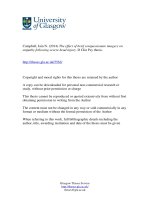
![ionescu - 2014 - the effect of mandatory partner rotation on audit quality [mapr]](https://media.store123doc.com/images/document/2015_01/06/medium_fam1420548198.jpg)
